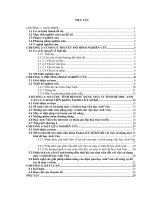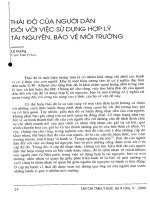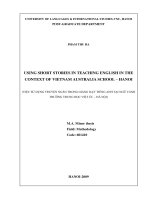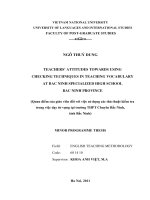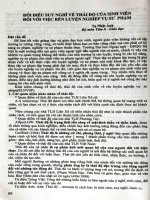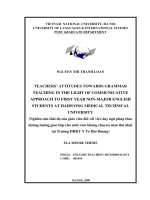Thái độ của giáo viên đối với việc sử dụng máy tính trong giảng dạy ngoại ngữ tại trường CĐSP Hà Nam
Bạn đang xem bản rút gọn của tài liệu. Xem và tải ngay bản đầy đủ của tài liệu tại đây (254.89 KB, 14 trang )
Thái độ của giáo viên đối với việc sử dụng máy
tính trong giảng dạy ngoại ngữ tại trường CĐSP
Hà Nam
Nguyễn Thị Chung
Trường Đại học Ngoại ngữ
Luận văn ThS ngành: Lý luận và pp giảng dạy tiếng Anh; Mã số: 60 14 10
Người hướng dẫn: Ph.D. Hoàng Thị Xuân Hoa
Năm bảo vệ: 2012
Abstract: Teacher’s attitude is considered as the key to successful integration of
computers in English language teaching. It can either be a hindering factor or a facilitator
for the use of computer. Since there has been a shift toward application of Information
Technology in the teaching and learning environment, a great number of researches have
been carried out to investigate the effectiveness of using computers for language teaching
and learning. However, the investigation into teachers’ attitudes toward the uses of
computers seems to be limited. Therefore, the aim of this study is to investigate teachers’
attitudes toward the uses of computers as well as factors affecting their uses of computers
in English language teaching at Ha Nam Teachers’ Training College and then compare
teachers’ attitudes with their classroom practice to find out correlation between them. In
order to achieve these aims, survey questionnaires and classroom observations were
employed. The results revealed that almost all the teachers had positive and favorable
attitudes toward the uses of the computers in their language teaching. On the other hand,
there are still difficulties that prevented teachers’ uses of computers namely lack of time
for preparation; lack of technical supports; lack of computer skills or training; lack of
teachers’ positive attitudes; lack of confidence and lack of computer facilities. The
findings of this study also suggests that in order to integrate computers in English
Language Teaching (ELT) successfully, the quality of classroom facilities and
technology equipments should be improved together with support and maintenance of
computer facilities at school. Furthermore, the better computer training courses are
needed.
Keywords: Giáo viên; Phương pháp giảng dạy; Máy tính; Tiếng Anh
Content
PART A: INTRODUCTION
1. Rationale
It can not be denied that computer technology has changed the face of education in many parts of
the world as well as in Vietnam in recent years. More and more uses of its unique features are
found every day and it is not surprising that the field of education is also being strongly affected
by this tool. As a result, English teaching and learning have been much easier and more effective
under the assistance of computers.
Using computers as English teaching tools is considered one of the most effective ways.
Remarkably, the Ministry of Education and Training (MOET) has planned for a significant
increase in ICT in education to take place in coming years and teachers are being encouraged to
incorporate ICT technology into their lessons. However, the investigations into teachers’
attitudes toward the uses of computers in language teaching seem to be limited in Vietnam.
Additionally, one factor in the successful implementation of computers in the classroom is
users’ acceptance, which in turn might be greatly influenced by users’ attitudes.
After five years of teaching English at Ha Nam Teachers’ Training College, the researcher
found that most of the teachers have integrated the computer technology into their teaching
curricula, however, their applications of computers may vary depending on their attitudes and
more importantly, the question whether teachers’ actual attitudes toward the uses of computers in
their classrooms have not been answered yet. Stimulated by the above reasons, the researcher has
decided to conduct the study on teachers’ attitudes toward the uses of computers in English
language teaching at HNTTC. Hopefully, the findings of this study will contribute to the
pedagogic methodology.
2. Aims of the study
The study is aimed at identifying the teachers’ attitudes toward the computer uses in
English language teaching at HNTTC and exploring some main factors affecting the teachers’
uses of computers in their teaching. Then teachers’ attitudes from the questionnaires and their
classroom practice are compared to find out whether there is correlation between them.
3. Research questions
1) What are the English teachers’ attitudes toward the uses of computers in language
teaching at Ha Nam Teachers’ Training College?
2) What are the factors affecting the teachers’ uses of computers in language teaching?
3) Do teachers’ attitudes correlate with their classroom practices?
4. Scope of the study
The study focuses itself on the investigation of teachers’ attitudes towards the uses of computers
in English language teaching in order to understand the teachers’ views on teaching with
computers as well as some main factors affecting teachers’ computer use. The participants are all
of teachers of English of Faculty of Foreign Languages and Informatics at HNTTC.
5. Method of the study
The study is carried out in form of a survey model. In order to achieve the above objectives,
two methods will be employed to collect the data including questionnaires and observation.
Questionnaires are used to investigate teachers’ attitudes towards the computer use in their
classroom and the data were analyzed quantitatively by percentage of statistics. At the meantime,
observation is to discover teachers’ actual behaviors, and then compare with teachers’ attitudes
collected from the questionnaire.
6. Significance of the study
The study is significant in the following ways:
- The first significance of the study is for the author herself to enhance the skills of conducting
the study in educational contexts and for the other ESL teachers at HNTTC.
- The study is aimed at investigating teachers’ attitudes towards the uses of computers in ELT,
which has not been carried out before in the context of HNTTC. Consequently, results of the
study will display the present situation of using computers in the teaching and contribute
appropriate ways to help teachers use computers in ELT more effectively.
- This study can also lay grounds for further research on using new technology in teaching
language and renovate the teaching language methods.
7. Organization of the study
The thesis is composed of three main parts: introduction, development and conclusion.
Part I is the introduction in which the rationale, aims, research questions, scope and
significance of the thesis as well as methods and some definitions of key terms of study are
presented.
Part II is the development. It consists of three chapters: literature review, methodology, data
analysis and discussions.
Part III is Conclusion part. In this part, concluding remarks, implications, limitations of the study
and some suggestions for further study are presented.
PART B: DEVELOPMENT
CHAPTER 1: LITERATURE REVIEW
1. 1.Attitude
1.1.1. Definition of attitude
1.1.2. Dimensions of attitudes
1.1.2.1. Beliefs
1.1.2.2. Feelings
1.1.2.3. Behaviors
1.1.3. The relationship between beliefs and behaviors of teachers
1.1.4. The relationship between feeling and behaviors of teachers
1.2. English Language Teaching
1.3. Computers in English Language Teaching
1.4. The roles and effectiveness of computers in English Language Teaching
1.5. Teachers’ attitudes toward computers in teaching
1.6. Factors affecting teachers’ uses of computers
CHAPTER 2: METHODOLOGY
2.1. Context of the study
The survey is conducted at Ha Nam Teachers’ Training College which is located in Phu Ly
city, a small city in the south of Hanoi capital, Ha Nam province, this college is a training unit in
the national education system. Students are trained to become teachers, administrators, and
professional staff of secondary schools, primary schools, and kindergartens with great passion
for education career, good political ethics, wide knowledge and skills in their major. Besides,
students are also trained to have the capacity to access knowledge and advance teaching methods
to meet the development requirements of education in the whole province. Furthermore, the
college provides office workers specializing in English for joint-venture companies in the
industrial zones in the city, trains interpreters and translators to work in the Middle-East
countries in Asia within the city’s project.
At Faculty of Foreign Languages and Informatics, there are 15 teachers of English, and five
teachers of Informatics. All teachers of English take responsibilities of teaching English for the
major groups and all other groups (non- major) where English is a compulsory course.
Of 15 teachers of English aged between 25 and 54 at the Faculty, there are 6 M.A degree
holders, four of them are studying for an M.A degree and the rest hold a B.A degree in English
language teaching. All of them are very friendly and enthusiasm.
At HNTTC, English is considered an extremely important subject to all students regardless
the majors they are learning. From 2006 Ha Nam Teachers’ Training College opened the classes
for students majoring in English. Up to now, there have been six classes majored in English.
Now there existed three English major classes and about thirty other majored classes such as
Physical Education, Maths, Biology, Accounting…. Almost all students come from rural areas of
Ha Nam such as Kim Bang, Ly Nhan, Thanh Liem, Binh Luc, and they still have very limited
access to Internet to find resources for studying.
Computers facilities
HNTTC is fully networked, giving wireless Internet connections in every classroom.
Students, however, have to bring their own computer to the classroom if they want to surf the
webs. There are over seventy classrooms:
Two fixed classrooms for teaching English majored students are fully equipped with a
computer, a projector, a loudspeaker and a DVD player for each; however, keeping these
computers in good quality is not very frequent.
Fifteen classrooms are equipped with projectors to facilitate the use of visual teaching
methods in some subjects for other students if necessary
Four computer rooms are for students to practice informatics.
The rest is not IT’s equipment.
In fact, most of the English teachers have their own laptops except two teachers (one over 40
and other over 50 years old) and they often take laptops with them anytime they go to work (both
inside and outside classrooms). Consequently, they are very easy to access computers anywhere
for their personal purposes.
There are four faculties, each is provided with two printers connected to computers: one for
dean and one for room staff. In addition, the school has licensed software for Microsoft Office on
all computers. This college is in a unique position where there has been a significant investment
in ICT.
More importantly, the college leaders always make ends meet for teaching equipment to
facilitate the teaching. In 2008, a computer-training course was organized for all teachers and
staffs within six weeks. In general, most of people took part in except some due to their personal
problems.
2.2. Participants
Fifteen teachers of English participated in this study, and all of them are female teachers.
They are from different parts of Ha Nam Province, mainly in Phu Ly city. Most of them are
married and have children; only three teachers are still single. Among these teachers, only one
teacher is more than 50 years old; two teachers are more than 40; two are above 30 and the rest
of them are all from 25 to 30 years old. Teachers who are more than 40 years old extensively
used traditional methods of teaching (blackboard and chalk) rather than with computer
technology. Among these, there are two teachers majored in Russian and one majored in French
so that to join teaching English officially, they had to study English to get English certificate
because French and Russian were omitted in the curriculum.
From the application of the new methods, they are very enthusiastic and flexible to update
Information Technology and integrate them in their teaching. Most of them used different
technologies to some extent in different situations either inside or outside the classroom. They
also used computers as a means of communications such as emails and a tool for preparing
lessons, designing tests, reports…. However, these teachers do not have their own Websites; they
often post the requirements for students by delivery of papers but rarely on the website of the
school.
2.3. Instruments for data collection
The questionnaires
A five-point Likert-scale questionnaires were employed as the basic instrument and developed
by the researcher to identify the teachers’ attitudes toward the uses of computers in English
language teaching. The development of questionnaires was guided by extensive review of
literature (Albirini, 2006; Ertmer, 2002; Jones, 2004; Kong Siew, 1997; Payette, 1987; Inch,
1987; Vakalis, 1990; Kersaint, Horton, Stohl, and Garofalo, 2003). To gain data for the research,
the questionnaires were administered to 15 teachers of English in Department of Languages and
Information Technology at HNTTC.
Before the actual data collection period, the questionnaires were first piloted to five
teachers to check its validity and reality. The piloted questionnaires then were re-edited. In order
to ensure the success of obtaining data, an advance notice was made to all teachers via group e-
mail to invite participation. After having the permission, the researcher made an appointment
with the teachers. The researcher explained why the information was being collected and how it
would be used. Then, the teachers were asked to spend their time reading the questionnaires and
to tick the statements in the questionnaires that came closest to expressing their feelings, beliefs
and behaviors concerning the uses of computers in their classroom on a 5-point scale.
The teacher questionnaires comprised three main sections as follows:
(1) Section 1 aims at teachers’ background.
(2) Section 2 elicits general attitudes of teachers toward the uses of computers in language
teaching.
(3) Section 3 aims at finding out the factors affecting teachers’ uses of computers in the
classroom.
Observation
Classroom observation is important in this study because it helps document teachers’
behaviors toward the uses of computers in their classroom practice and enhances rater reliability.
It was conducted within a month; the researcher observed ten lessons by seven teachers at
HNTTC to get a quick view on teachers’ uses of computers and document teachers’ actual
performance in their teaching. Then, the result of the observation would be compared with the
result of the questionnaires in order to state whether what teachers say was consistent with what
they did in their classroom. Seven of the teachers aged from 25 – 30 years old were selected.
Each of category, in the observation was presented on 5– point scale used as the rating to
document teachers’ actual behaviors in ESL classrooms, with five fixed alternatives to choose
from “never”, “rarely”, “sometimes”, “usually”, “always” (Appendix B)
The observation checklists were developed by the researcher for identifying teachers’ uses
of computers in classroom, the elements in the checklist were given assessment. The checklist
includes five criteria:
Types of computer used
How activities are presented
How slides are presented
How soft wares are presented
Some problems in using computers in the classroom
2.4. Procedure of data analysis
After all the data were gathered, they were transformed and classified according to the
two research questions. From the data analysis, a large amount of statistics obtained from the
questionnaire was transformed into tables and charts, which reassured the clear-cut format and
facilitate the analytical task as well as help readers understand more easily.
Regarding classroom observation, the researcher made a thorough analysis on the
observation checklist. The results then were compared with those of the questionnaires.
CHAPTER 3: DATA ANALYSIS AND DISCUSSIONS
3.1. Data Analysis
3.2. Discussions of the findings
3.2.1. Research Question 1
The first research question of the study is “What are the English teachers’ attitudes toward the
uses of computers in language teaching at Ha Nam Teachers’ Training College?” The results of
the study from the statistics above show that most of the teachers have positive attitudes towards
using the computers to teach English through three dimensions of attitudes (feelings, beliefs and
behaviors). This result is accordance with the finding from a study of Albirini (2004). He
conducted a study to investigate the attitudes of EFL teachers toward ICT which was taken into
account the three components of attitudes: affective, cognitive and behavioral, and the results
from both quantitative and qualitative data indicated that teachers had positive attitudes toward
technology use in education.
The first, concerning teachers’ feelings toward the uses of computers in ELT, most of the
teachers preferred using computers in their classrooms; they were more self-confident with the
assistance of computers in their teaching. Furthermore, they still want to learn more about
computers to aid them in ELT. This means that most of the teachers wanted to use computer
technology for teaching purposes but they did not have enough knowledge about how to use
them in teaching. Therefore, teachers’ training needs for computer uses are necessary because of
useful computers in teaching. As for the value of using computers during the lessons, the
teachers mentioned that computers were very enjoyable and stimulating. Therefore, they were
more enthusiastic and had positive attitudes towards this application. However, a few teachers
still existed nervous or uncomfortable when using computers. Much of the anxiety and
uncomforting surrounding the uses of computers can relate to some factors such as lack of
confidence, lack of computer training….which will be referred in detail later. In short, most of
the teachers at HNTTC had positive feelings toward the role of computers in their teaching, and
they liked using computers in their classroom.
The second is teachers’ beliefs toward the uses of computers. The majority of teachers
expressed that the computers would help the English lessons become more interesting, exciting
and effective and thus motivate the students. In general, most of the teachers used computers to
prepare the lessons. They believed that computers were useful and effective tools to improve
educational environment. Obviously, these made them have positive attitudes toward the uses of
computers.
Regarding the behavioral dimension of attitude, the results of questionnaires indicated that
almost all teachers often used computers; designed PowerPoint lessons, Microsoft (MS) lesson
plans; searched materials such as pictures, video, useful knowledge…from the Internet to make
their lessons more interesting.
The relationship among dimensions of attitude in this study showed the consistency that if
teachers had a positive feeling and thought positively toward the uses of computers then their
actions and behaviors toward computers would be positive, and conversely with a few teachers
who had negative thinking and feelings toward the uses of computers.
3.2.2. Research Question 2
The second research question is “What are the factors affecting the teachers’ uses of computers
in language teaching?”
Although the findings revealed that teachers held favorable attitudes toward the uses of
computers, there were still factors in the context that prevented them from fully utilizing the
computer in their teaching. Firstly, all of the teachers agreed that it took a lot of time when they
taught English with the help of computers. Maybe, when they wanted to teach any lessons, any
English skills, they had to spend a lot of time to find information, classify them and design PPT
lessons which is not only the barrier to the teacher who has limited computer knowledge but also
to those who have better computer skills. This was supported by John (2004) who said that
teachers were sometimes unable to make full use of technology because they lacked the time
needed to fully prepare and research materials for lessons. Apart from that, the lack of computer
skills/ training discouraged the frequent uses of computers in an ESL classroom. Due to their
lack of computer knowledge and skills, teachers needed more time to create teaching materials;
as a result, they were not confident to utilize the technology in their teaching. They felt that they
were incompetent and uncomfortable using the computer in the classroom as evidenced from
some previous studies namely Ertmer (2002), Jones (2003) and Kong Siew (1997). Obviously,
lack of confidence was one of the factors hindered teachers’ uses of computers in ESL classroom
(Ertmer, 2002). Some of them may have a negative attitude towards the uses of computers in the
classroom especially among teachers who had lower perceived abilities of handling the computer
and who are old-aged, they rarely had computer experience in their life. Additionally, lack of
computers also affected teachers’ attitudes toward the uses of computers in their teaching
significantly. In studies conducted by Ertmer (2002) and Kong Siew (1997), they indicated that
lack of computers inhibited teachers’ uses of computers in the classroom and this was teachers’
opinions at HNTTC. However, the researcher found that it was not consistent with the result of
the observations. In spite of the fact that computers are available in the classrooms for English
majored students, teachers who own laptop computers seemed to like using their personal
computers instead of desktop computers. Perhaps, this is due to limited software in the school
and lack of knowledgeable personnel or technician on-site for computer maintenance as well as
provision of technical support to teachers. Therefore, technical supports from the school
authorities played an important role to encourage teachers to utilize computers effectively
(Ertmer, 2002). Another important reason is teachers’ attitudes which really made teachers
unmotivated or motivated to use computers in the classroom although they knew about their
advantages very well. It was regarded as the first factor deciding whether this integrating
successful or not. Understanding of their attitudes towards the uses of computers in language
teaching helps to gain insights into what they do in the classroom and why they do it.
3.2.3. Research Question 3
The third research question is “Do teachers’ attitudes correlate with their classroom practice?”
It can be stated that teachers’ classroom practices were totally consistent with what they said
in the questionnaires. It meant that there was significant correlation between teachers’ attitudes
and their actual behaviors toward the uses of computers. Most of the teachers at HNTTC were
keen on and more confident using computers in their teaching because they understood and
appreciated the roles and effectiveness of integrating IT in teaching mostly were useful,
interesting…
In short, the positive feelings and beliefs of the teachers can motivate their computer use in
their classroom which involved Kersaint, Horton, Stohl, and Garofalo (2003). They indicated
that teachers who have positive attitudes toward technology feel more comfortable with using it
and usually incorporate it into their teaching. This was partly supported by a study from
Simonsson (2004) who studied the relationship between teachers’ beliefs of the use of
technology and their actual integration of technology in their classes. The findings of this study
showed that the utilization of technology was related to teachers’ beliefs. In fact, teacher’s
beliefs strongly affected technology integration.
PART C: CONCLUSION
1. Conclusion
Most of the teachers at HNTTC have positive attitudes toward using the computers to teach
English. In their opinions, the uses of computers in an ESL classroom made the lessons more
interesting, exciting and effective.
Moreover, the findings also revealed that number of teachers with knowledge on computer
skills to handle fundamental computer operation skill in teaching outnumber those with little
knowledge.
In addition, the findings of the study indicated some common difficulties that prevented
them using computers in an ESL classroom effectively namely lack of time for preparation; lack
of technical supports; lack of computer skills/ training; lack of teachers’ positive attitudes; lack
of confidence, and lack of computers.
Furthermore, the data also showed significant correlation between teachers’ attitudes and
their actual classroom practice.
In conclusion, the present study has provided insightful information about the teachers’
attitudes towards the uses of computers through three dimensions: feelings, beliefs and behaviors
and the relationships among them. Apparently, what teachers said is consistent with what they
performed in their classroom and the difficulties they faced with. Therefore, understanding
teachers’ attitudes toward the uses of computers in teaching is likely to give contribution for
future intervention.
2. Implications
For educational authorities: In order to encourage the teachers at HNTTC to use computers in
their lessons more eagerly, authorities can provide the appropriate teaching environment for
them:
The first thing is to invest and improve the quality of classroom facilities and technology
equipments. The most urgent demand is that projectors should be available at every classroom
so that teachers can use their laptops for the lessons.
The second is to implement and provide better training IT courses to help teachers gain
further knowledge of IT and familiarize with some applications of IT such as Violet, Hot
Potatoes, Adobe Audition, and website designing…
Finally, technical supports and maintenance of computer facilities at schools should be
always up-graded and maintained well.
For teachers: Teachers should have enough knowledge about the computer and IT. Teachers
need to attend education and training courses, frequently visit the site and members of forums to
exchange the information.
Furthermore, each teacher should be aware of the needs, roles and effectiveness of
applying IT in teaching English and coordinated other teaching methods.
3. Limitations of the study
Due to the time constraints and limited scope, the study remains certain following
limitations:
- The first one is the size of the survey, the distribution about sex of the sample is
unbalanced; all of them are female that may seriously weaken the accuracy of the data.
- Another limitation of this study is that no interview was carried out by the researcher to
understand more about teachers’ attitudes toward the uses of computers in their teaching.
-The question of confidentiality is the third issue.
4. Suggestion for further study
Further research using interview, might be carried out to understand more to what extent
teachers apply computers in their language teaching.
Participants in the study are only 15 teachers of English at HNTTC, which partly narrowed
the scope of the participants; thus, the results cannot be generalized to other educational contexts.
Furthermore, the distribution about sex of the sample is unbalanced; all of them are female that
may also seriously weaken the accuracy of the data. Further studies may include teachers with
balance of sex from some colleges from other EFL contexts at Ha Nam.
Concerning the factors hinders teachers’ uses of computers; further research can also be
recommended to examine other factors than those in this study.
References
Albirini, A. A. (2004). An exploration of the factors associated with the attitudes of high school
EFL teachers in Syria toward information and communication technology. Unpublished
thesis, The Ohio State University.
Albirini, A. A. (2006). Teacher’s attitudes toward information and communication technologies:
the case of Syrian EFL teachers. Journal of Computers and Education, 47(4), 373-398.
Ajzen, I., & Fishbein, M. (1977). Attitude – behavior relation: A theoretical analysis and review
of empirical research. Psychological Bulletin, 84, 888-918.
Compeau , D. R., Higgins, C. A., & Huff , S. ( 1999 ). Social cognitive theory and individual
reactions to computing technology: A longitudinal study. MIS Quarterly, 23(2), 145-158.
Eugene, J. (2006). How teachers integrate technology and their beliefs about learning: Is there a
connection?. Journal of Technology and Teacher Education, 14(3), 581-597.
Ertmer, P. A. (2002). Addressing first- and second-order barriers to change: Strategies for
technology integration. Educational Technology Research and Development, 47(4), 47-
61.
Jones, A. (2004). A Review of the Research Literature on Barriers to the Uptake of ICT by
Teachers. British Educational Communications and Technology Agency. Version 1.
Hadley, M., & Sheingold, K. (1993). Commonalities and Distinctive Patterns in Teachers’
Integration of Computers. American Journal of Education, 101, 261-315.
Hogg, M., & Vaughan, G. (2005). Social psychology (4th ed.). London: Prentice Hall.
Inch, B.A. (1987). Change triggered computer technology: its implications for faculty
development. Doctoral dissertation, The University of Wisconsin – Madison.
International Dictionary of Education. (1977). London: Kogan Page.
Kersaint, G., Horton, B., Stohl, H., & Garofalo, J. (2003). Technology beliefs and practices of
mathematics education faculty. Journal of Technology and Teacher Education, 11(4),
549–577.
Mansour, N. (2009). Science teachers’beliefs and practices: Issues, implications and research
agenda. International Journal of Environmental & Science Education, 4(1), 25-48.
OTA. (1995). Teachers and technology: Making the connection. Washington, DC: U.S:
Government Printing Office.
Oxford Advanced Learners’ Dictionary of Current English. (2010).
Payette, D. L. (1987). The use of computer technology by senior administrator in colleges and
universities. Doctoral dissertation, New York University.
Percival, F. (1984). A Handbook of Education Technology. Billings & Sins Limited Worcester.
Rahman, F. A. (2000). Paper presented at the International Conference. Education & ICT in the
New Millenium. Park Royal, Kuala Lumpur.
Saaid. N. (2010). The use of Technology (Audiovisual Aids) in teaching English as a foreign
language in Benghazi secondary schools. Unpublished Master thesis, Leicester
University.
Samak, Z. A. (2006). An exploration of Jordanian English Language teachers’ attitudes, skills,
and access as indicator of Information and Communication Technology integration in
Jordan. Unpublished Doctoral Thesis, Florida State University.
Simonsson, M. (2004). Technology use of Hispanic bilingual teachers: A function of their
beliefs, attitudes and perceptions on peer technology use in the classroom. Journal of
Instructional Technology, 31(3), 257-266.
Vakaslis, M. P. (1990). Variables related to faculty attitudes toward computing at Western
Michigan University. Doctoral dissertation, Western Michigan University.
Warschauer, M. (1996). Computer-assisted language learning: An introduction. In Fotos (ed.)
Multimedia language teaching, 3-20. Tokyo, Japan: Logos International. Retrieved May,
2007 from: http://www. gse.uci.edu/faculty/markw/call.html
Warschauer, M., & Healey, D. (1998). Computers and language learning: An overview.
Language Teaching, 31, 57-71. Retrieved from:
./wiki/computer-assisted-language learning.
